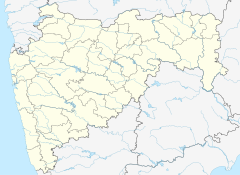Alamgir Mosque, Aurangabad
| Alamgir Mosque, Aurangabad | |
|---|---|
| Religion | |
| Affiliation | Islam |
| District | Aurangabad |
| Status | Active |
| Location | |
| Location | Qila Arq, Aurangabad |
| Municipality | Aurangabad Municipal Corporation |
| State | Maharashtra |
| Country | India |
| Geographic coordinates | 19°53′45″N 75°19′58″E / 19.895814456186013°N 75.33279110000001°E, |
| Architecture | |
| Style | Mughal architecture |
| Founder | Aurangzeb Alamgir |
| Completed | 1693; 331 years ago |
| Dome(s) | 3 |
The Shahi Mosque, also known as the Alamgiri Mosque, is located in Aurangabad, a city in Maharashtra, India. It was built in 1693 by Mughal emperor Aurangzeb for his private use. It is one of the few surviving structures of the Qila-e-Ark, a fortified palace complex built as Aurangzeb's residence in Aurangabad, and is situated in its eastern flank. The structure was referred to as the Alamgiri Mosque as late as the twentieth century, and it is commonly known as the Shahi Mosque in the modern era.[1][2]
The mosque's prayer hall has a triple-vaulted roof, and features curved bangla cornices. It is topped by three fluted domes. The facade of the mosque bears three trilobed/trefoil arches. The Shahi Mosque's type and architecture finds precedent in the Moti Masjid (Red Fort), another private mosque built by the emperor in Delhi, which in turn draws from Shah Jahan-era mosques in Lahore and Agra. Michell and Zebrowski have characterised the mosque's architecture as "unusual" in comparison to other Mughal mosques of Aurangabad, such as the Chauk mosque or Lal mosque.[1][2][3]
Gallery[edit]
-
Alamgir mosque at Kila-e-Ark 1880s
See also[edit]
References[edit]
- ^ a b Sohoni, Pushkar (20 December 2016). "A Tale of Two Imperial Residences: Aurangzeb's Architectural Patronage". Journal of Islamic Architecture. 4 (2): 64–66. doi:10.18860/jia.v4i2.3514. ISSN 2356-4644.
- ^ a b Michell, George (1999). Architecture and art of the Deccan sultanates. Mark Zebrowski. Cambridge: Cambridge University Press. p. 111. ISBN 978-0-511-46884-1. OCLC 268771115.
- ^ "Aurangzebe's Private Mosque, Aurangabad (The J. Paul Getty Museum Collection)". The J. Paul Getty Museum Collection. Retrieved 13 September 2023.


